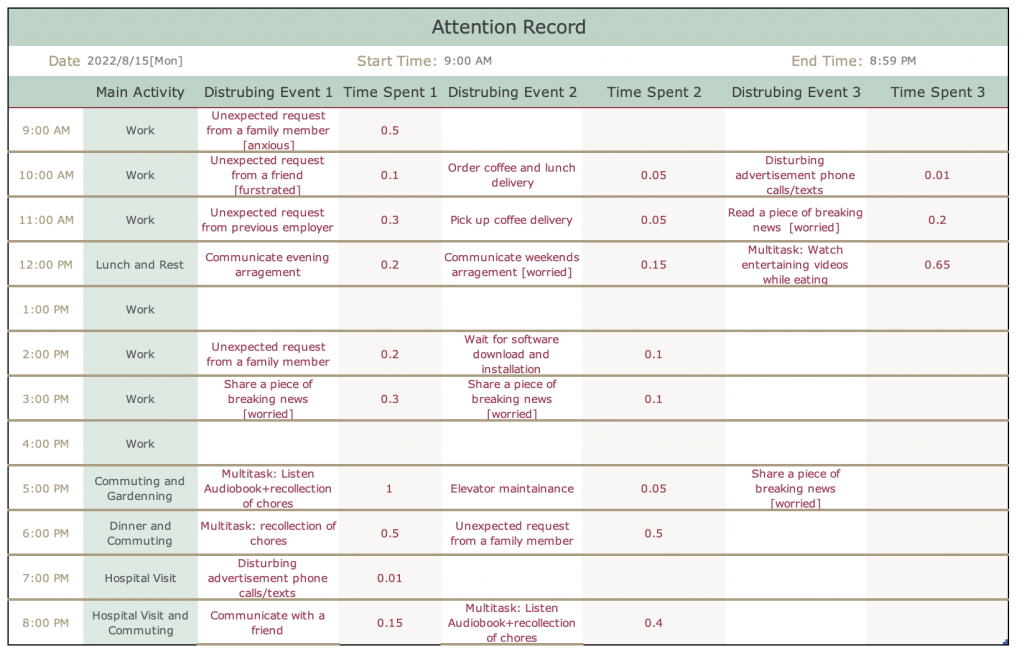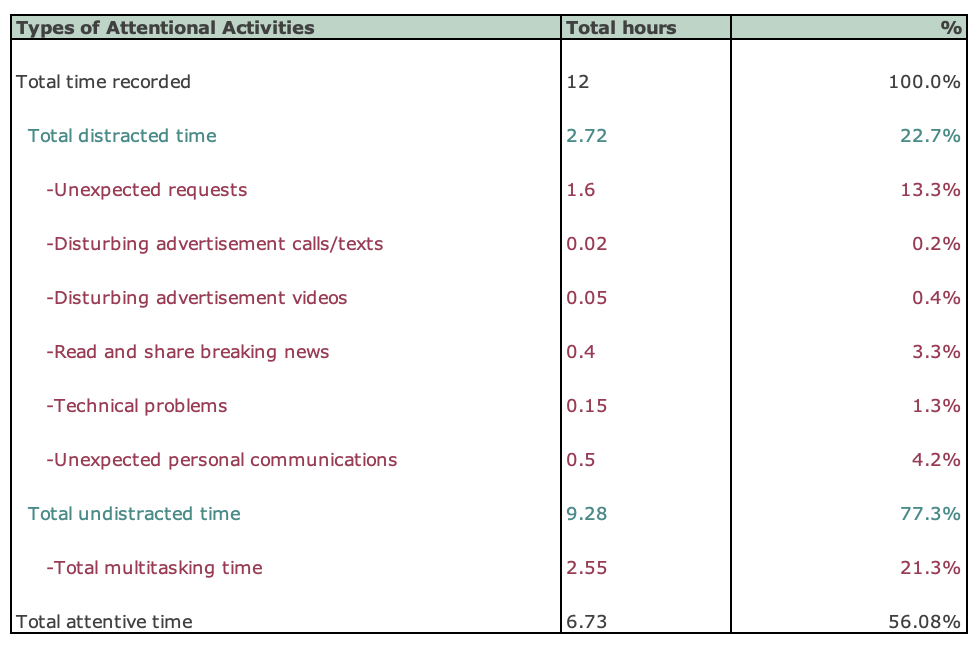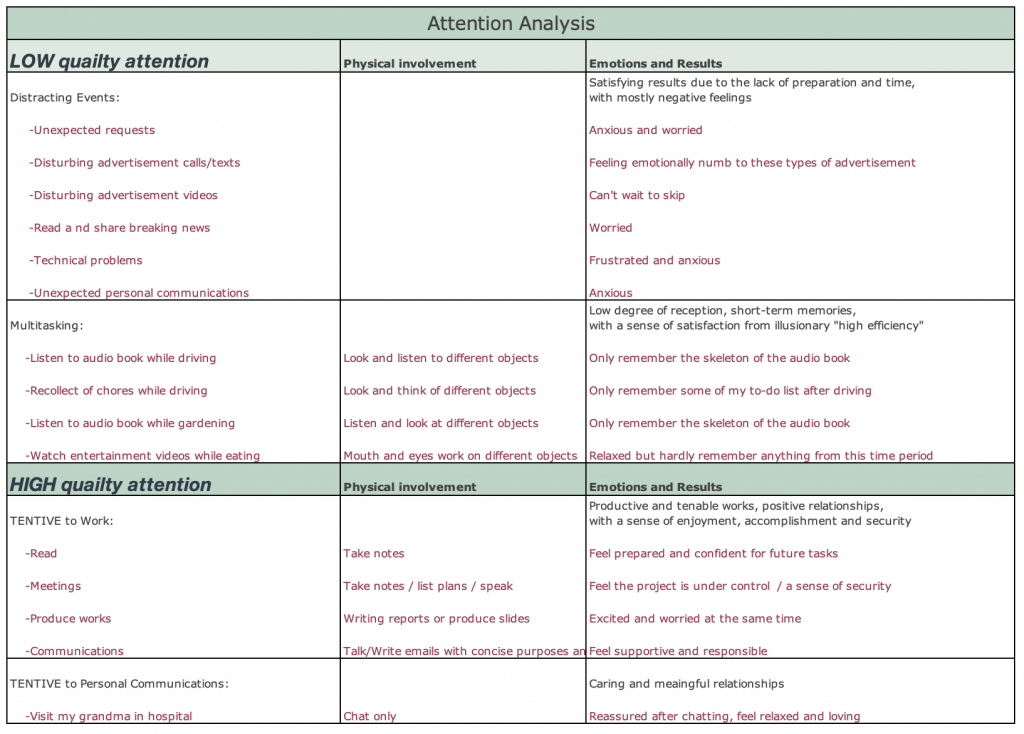12-hour Record of My Attentional Activities




Since I am an analyst studying the education technology industry, I am wary of the attention economy tactics spread through the mass media and have taken precautions to avoid devoting my attention to unnecessary entertainment activities. However, throughout learning the attention ecology and recording my attentional activities, I have come to understand that the design of modern “mediarchy” (Citton, 2017) has inevitably disrupted my life and use of attention from all aspects.
As I documented and summarized in the pie chart above, during 12 hours of a regular workday (from 9:00 am to 8:59 pm), I was only paying full attention to my main activities for 56% of the time at most. If I subtract the time for small breaks, I might not be able to focus on my main activities even half of the time during a workday that I considered productive and highly rewarding. One of the biggest distractions is the behaviour I thought efficient: multitasking. I usually choose to listen to an audiobook or recollect chores during times when I don’t need to be very focused such as driving and gardening. But as I analyzed the results of multitasking, I was surprised to find that the little attention diverted away from listening and thinking didn’t seem to bring me the benefits I expected since I hardly recall anything from these periods the next day. The father of the attention economy Herbert A. Simon (1976) suggested that multitasking is an illusory myth rather than a practical skill since human beings are single-minded. This content was also confirmed by the analysis of my disappointing attention results.
Another discovery was that despite all the measures I took to prevent distraction of attention because of my aversion to interruptions, today’s convenient instant communication tools have significantly reduced my ability to focus. Some of the precautions I use are:
- Turn the computer into “Do Not Disturb” mode to stop system/software upgrades and popping up breaking news from all over the world.
- Turn on a focus app on my phone in order to prevent me from checking personal messages too often.
- I deleted all the addicted video-based apps from my phones.
- I always prepare a notebook aside from the computer, encouraging myself to take notes while reading.
However, from the 12-hour analysis above, I still spent 21% of my time dealing with storming messages, urgent requests from family members and friends, advertisement texts/phone calls/videos, pick-up notifications, and breaking news. Most of the time, I was anxious and worried about these prompt communications because I needed to juggle my main tasks at the same time. As a result, I had to perfume these chats and requests because I did not have enough time or attention. This phenomenon validates that while modern technologies enable convenient and instant communications, they no longer give us the space to wait and develop a steady pathway of attention use (Citton, 2017, p. 172).
Based on my observations and analysis of some of my failures and successes in managing attention, I summarize the following learning approaches that will help learners better control their use of attention:
- Nowadays, we heavily rely on technology to learn and work. But varieties of devices and software consume enormous attention to maintain good use conditions, such as long learning processes, malfunctions, installations and updates. Thus, educational practitioners should carefully select appropriate learning tools and provide prompt technical support in order to prevent unnecessary technological distractions.
- Teachers need to understand effective learning happens while students pay attention to their own learnings (Ranciere, 1991, p. 26). Thus, teachers should suggest various learning methods and flexible learning objectives.
- Teachers should encourage students to increase the level of cognitive engagement, such as taking notes while reading, creating a meaningful artifact, and discussing with each other.
- Teachers should discourage students from multitasking behaviour for serious learning.
Overall, teachers need to understand that the use value is essential in an attention ecology instead of the exchange value, especially for learning purposes. Thereby educators should lead students to initiate their own learning engagements, foster students’ ability to manage their attention actively, and create a less distracting learning environment in today’s world of mediarchy.
References:
Citton, Y. (2017). Introduction and Conclusion: From Attention Economy to Attention Ecology. In The Ecology of Attention. John Wiley & Sons.
Simon, H. A. (1976). Administrative behavior: A study of decision-making processes in administrative organization (3rd ed.). The Free Press.
Ranciere, J. (1991). The Ignorant Schoolmaster (Vol 1). Stanford, CA: Stanford University Press